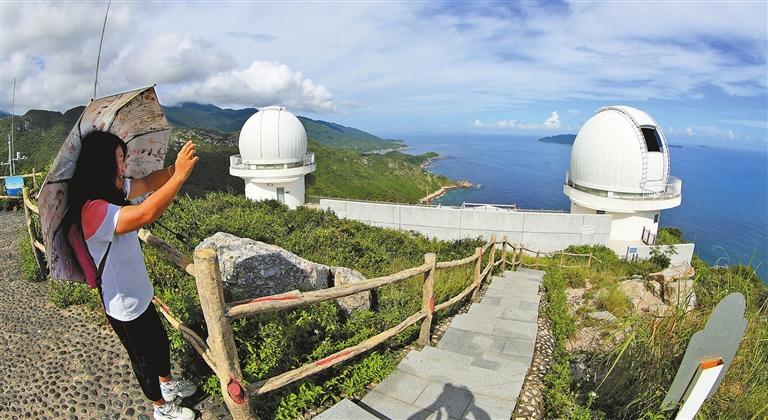

Song Yingwen ywennsong@hotmail.com HOW many stars do you think one can spot in the night sky on a clear day in downtown Shenzhen? The number is approximately 20, limited to only the brightest ones, according to Mei Lin, head of the Shenzhen Astronomical Observatory’s Astronomy Department. Is there any chance that Shenzheners could have a glimpse of the Milky Way without painstaking efforts to travel afar? The answer is yes, and it takes only around a 90-minute drive from Futian District. The destination would be Xichong in Dapeng New Area in eastern Shenzhen, the second International Dark Sky Community in Asia and the first in China. On darkmap.cn, a Chinese website that provides professional data for stargazers, the Light Pollution Map rates downtown Futian at Bortle class 8, while the reading for Xichong is Bortle class 4. “That means while you see a modest display of around 20 stars in Futian, visitors can expect a star count of 1,000-2,000 in Xichong,” Mei said. The Bortle scale is a numeric scale that informs the brightness of the sky above a given location. It has nine levels from class 1, which is the darkest sky you can find on Earth, to class 9, which is the most light-polluted city sky. For most of us, getting to a Bortle-class 3 to 4 location is dark enough for a great stargazing experience. The constellations are always there, but global light pollution is drowning them out in many parts of the world. Yet there are people like Mei who believe we should find ways to preserve the long-existing stargazing tradition. Mei and his teammates, including government officials, astronomers, experts in lighting and city planning, found a solution for Shenzheners: To create a dark sky community. After two years’ effort, Xichong in April was officially recognized as one of the 42 International Dark Sky Communities in the world. Dimmed lights Xichong conducted extensive surveys of outdoor lighting facilities and from August 2021 through June 2023 implemented retrofitting projects to improve community lighting. It also organized a number of educational programs highlighting the negative effects of light pollution. As a result, over 51% of the lighting facilities have been upgraded. In the eyes of Ruskin Hartley, CEO and executive director of the International Dark-Sky Association, Xichong serves as a model not only for other cities in China but also globally. Recognizing the alarming 10% annual increase in global light pollution, the association sees Xichong as a shining example of dark sky preservation, as Hartley shared with Shenzhen Daily during the plaque-awarding ceremony in April. “Xichong is currently the only International Dark Sky Community in the four global bay areas: the San Francisco Bay Area, New York Bay Area, Tokyo Bay Area and Guangdong-Hong Kong-Macao Greater Bay Area,” Mei said. “This community outranks all the other regions in this category in population, the number of visitors and the frequency of educational programs held every year,” he explained. A radiant future On Xiaohongshu, China’s most popular social commerce platform, stargazing has now become the most recommended recreation choice for tourists to Xichong. This new identity has undoubtedly raised Xichong’s profile as a travel destination, especially at a time when astrotourism is on the rise. Astrotourism has a disproportionately high economic impact as it requires overnight stays and benefits from the winter nights. Liu Jiyin, who runs an eight-room guesthouse in Yashan Village in Xichong, estimates that more than 50% of his annual income in 2023 will come from organizing stargazing tours for visitors, a significant increase from the previous 10-20% in 2022. Liu, who shifted his business focus from Guilin in Guangxi to Xichong in 2019, said the establishment of the International Dark Sky Community gave an extra boost to his business. Serious astrophotography enthusiasts also welcome the changes brought about by the designation. Xu Lianda, an experienced nighttime photographer who has spent the last decade capturing the night sky around the world, says that light pollution in Xichong has significantly decreased in the past two years. Although there may be better locations in northwestern China for stunning star views, traveling there with heavy photography equipment is time-consuming and expensive, and requires significant energy. “But here in Xichong, visitors have plenty of choices for accommodations and dining. They can spend their daytime enjoying the sea view and exploring the hiking routes. At night, they can immerse themselves in the mysterious beauty of the universe. It’s truly an exceptional experience,” Xu said. Pride and pressure Both the city government and the observatory have been dedicated to attracting visitors to Xichong. In order to mitigate the effects of light pollution, the city has implemented regulations on lighting facilities and more are being drafted. To promote astronomical observation and educational initiatives, the observatory has sought partnerships with prominent enterprises, utilized social media platforms to expand the community’s reputation, and hosted concerts and parties to attract visitors. Over the past two years, over 300,000 tourists have visited the community, yielding more than 20 million yuan (US$2.75 million) of tourism revenue. However, Mei acknowledges the challenges that lie ahead. He urges the community to be adequately prepared to handle the impending surge in tourism. From his perspective, the community still falls short in providing quality tourism services. “We need professionals to help design and manage projects and activities. Enhancements to public facilities are necessary to meet the demands of professional stargazers and photographers. But above all, we need appropriate legislation to curb light pollution and facilitate nature conservation,” he said. | 
